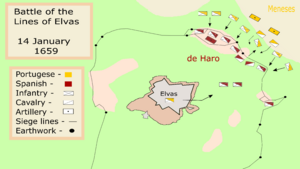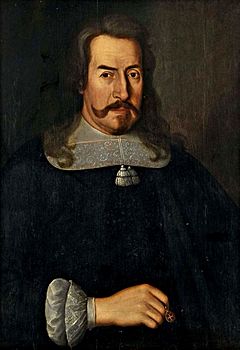Battle of the Lines of Elvas facts for kids
Quick facts for kids Battle of the Lines of Elvas |
|||||||
|---|---|---|---|---|---|---|---|
| Part of the Portuguese Restoration War | |||||||
 Battle of the Lines of Elvas |
|||||||
|
|||||||
| Belligerents | |||||||
| Commanders and leaders | |||||||
| Strength | |||||||
| 10,500 50 cannon |
15,800 10 cannon |
||||||
| Casualties and losses | |||||||
| 898 killed, wounded and captured | 11,200 killed, wounded and captured | ||||||
The Battle of the Lines of Elvas was a major fight between Portugal and Spain. It happened on January 14, 1659, near the city of Elvas, Portugal. This battle was part of the Portuguese Restoration War, which was a long conflict. The battle ended with a big victory for Portugal.
Contents
Why the Battle Happened
By 1659, the war between Portugal and Spain had been going on for a long time. It was like a tie game, with neither side winning clearly. Most of the fighting was small raids across the border. Neither the Spanish nor the Portuguese armies could win a big battle.
Philip IV of Spain wanted to end the war. He planned to attack and capture a major Portuguese city. His idea was to force the Portuguese army to come and help. Then, he could destroy their army in a big fight.
Elvas: A Key Target
The city of Elvas was chosen as the target. It was a threat to the Spanish city of Badajoz. For example, in 1644, a Portuguese army from Elvas had attacked Spanish towns. Capturing Elvas would also open a path for the Spanish army. They could then march towards Lisbon, the capital of Portugal.
The Portuguese leaders knew Elvas was in danger. They had made the city's defenses much stronger during the war. However, the soldiers in Elvas were not fully ready for a siege. Also, most of the Portuguese army was far away in the north. They were waiting for a possible Spanish attack there.
The Spanish Attack
In December 1658, a Spanish army arrived near Elvas. It was led by Luis de Haro, a powerful Spanish noble. His army had about 14,000 foot soldiers, 3,500 horse soldiers, and many cannons.
The Spanish spent several days getting ready for the siege. This gave the Portuguese time to prepare Elvas even more. De Haro's soldiers dug trenches around the city. They were ordered to stop anyone from getting close. The Spanish also started firing cannons at Elvas. This caused panic and many deaths among the people inside. Disease also spread, killing hundreds every day. The siege lasted for many weeks.
Portugal's Relief Plan
The only way to save Elvas was for a relief army to arrive. Queen-Mother Luisa de Guzman decided to act. She called António Luís de Meneses to lead all Portuguese troops in the area. She also sent Sancho Manoel de Vilhena to help.
Meneses faced many problems getting supplies. But he managed to gather an army in Estremoz. He brought in new soldiers from different areas. He also combined soldiers from several nearby towns. His army had 8,000 foot soldiers, 2,500 horse soldiers, and seven cannons.
The Portuguese horse soldiers were very strong. They were led by General André de Albuquerque Ribafria. He was known as the best commander of horse soldiers in the war. He had made the Portuguese cavalry a very strong fighting force.
In early January, the Portuguese army left Estremoz. They marched towards Elvas. Instead of taking the easy main road, they went north and east. On the night of January 16, they reached the hills northeast of Elvas. From there, they could see the city and the Spanish army.
The Battle Begins
On January 17, around 8 in the morning, the Portuguese army moved forward. They were on the hill of Assomada. They began to advance towards the Spanish lines. A thick fog covered them as they moved into the valley.
Around 8 AM, the Portuguese attacked the Spanish army. They fought near a village called Murtais. The Portuguese foot soldiers fought very fiercely. They pushed the Spanish out of their trenches. When the Spanish horse soldiers tried to help, the Portuguese cannons fired at them. Meneses used his foot soldiers and cannons together. This stopped several Spanish cavalry attacks.
Portuguese Counter-Attack
Then, the Portuguese horse soldiers were ordered to attack the retreating Spanish cavalry. Even though the Spanish had more horse soldiers, the Portuguese drove them away. This victory was largely thanks to General Ribafria. He wanted to crush the Spanish cavalry while they were on the defensive.
With these early successes, Meneses split his army. One part attacked the Spanish trenches directly. The other part went around the right side of the Spanish army. De Haro had lost most of his horse soldiers. Because of this, he did not know about this flanking move.
From his position on Assomada hill, Meneses gave a signal. The soldiers inside Elvas then rushed out to join the attack. Meanwhile, De Haro kept fighting a defensive battle. He focused on his trench line. He failed to deal with the Portuguese forces circling his army.
Spanish Defeat
By mid-afternoon, the Spanish were fighting hard to defend their lines. But Meneses's plan of attacking from two sides began to wear them down. The Spanish defenders were now being attacked from many directions.
De Haro tried to change his strategy, but it was too late. The Spanish lines finally broke. Thousands of soldiers ran away in a panic. Meneses quickly chased the Spanish army. He kept attacking them for three days as they retreated to Badajoz in Spain. Many Spanish soldiers got trapped against the Caia river. They were forced to surrender.
The Spanish defeat was complete. Their artillery soldiers could not even disable their cannons before the Portuguese captured them. Meneses took 22 cannons and other valuable items.
Spanish losses were very high. Out of 17,500 men, only 5,000 foot soldiers and 1,300 horse soldiers made it back to Badajoz. The Portuguese lost about 200 killed and 700 wounded. The most famous Portuguese loss was Ribafria. He was killed while leading an attack on a strong Spanish position.
After his victory, Meneses received many honors. He was given the title of Marquis of Marialva in 1661. Six years later, at the Battle of Montes Claros, Meneses used a similar strategy. He used it to defeat another Spanish cavalry attack.
Today, a monument stands where the battle took place. The Garrison Border Town of Elvas and its Fortifications was named a World Heritage Site in 2012.
Pictures
Sources
See also
 In Spanish: Batalla de las Líneas de Elvas para niños
In Spanish: Batalla de las Líneas de Elvas para niños






